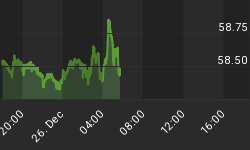Bulls Get Good Manufacturing Report

On Wednesday, we noted stock market bulls needed some good economic news. They got it Thursday. From Bloomberg:
U.S. stocks rose as a better-than-forecast report on manufacturing tempered concern about the strength of the economy while Facebook Inc.'s $19 billion purchase of a messaging startup sparked optimism about deals. Data today showed the Markit Economics preliminary index of U.S. manufacturing increased to 56.7 in February, surpassing economists' estimates, while Labor Department figures indicated fewer Americans filed applications for unemployment benefits last week. The Conference Board's index of U.S. leading indicators, a gauge of the outlook for the next three to six months, rose in January in line with estimates.
Tech Still Looking Good
On December 26 the S&P 500 closed at 1,842. Eight weeks later, during Thursday's session, the S&P 500 was trading at 1,841. You would think the stock market bears would be making some good progress behind the scenes during a "going nowhere" period. That has not been the case; at least thus far. For example, the technology sector continues to lead. The weekly chart of the NADAQ below continues to show a healthy and bullish trend.

Is There Defensive Posturing?
If investors and money managers were highly concerned about the current state of the global economy, we would expect to see rising demand for defensive consumer staples stocks. That is not what we have. The chart below shows the demand for consumer staples stocks (XLP) relative to the S&P 500 (SPY). We noted the bearish shift in the chart below on December 27. Not much has changed in the last eight weeks.

Inflation Getting Closer To Fed's Target
With weaker than expected data surfacing in both emerging markets and the United States, you may wonder why the Fed is so intent on tapering. While there are numerous answers, one of them is related to concern about future inflation. From The Wall Street Journal:
Consumer prices held nearly flat last month, reflecting tepid overall inflation across the economy as the Federal Reserve rolls back one of its key easy-money policies. The consumer-price index, which measures how much Americans pay for everything from hospital visits to heating oil, advanced a seasonally adjusted 0.1% in January from the prior month, the Labor Department said Thursday. Core prices, which strip out volatile food and energy costs, also were up 0.1%. Compared with a year earlier, overall consumer prices increased 1.6%. That was the strongest year-over-year gain since July, moving closer to the Fed's 2% target for annual inflation.
Investment Implications
Until the markets signal a shift from risk-on to risk-off, it is prudent to maintain some patience with stocks, even during an eight week period of little to no progress. Our allocations have not changed this week. We continue to own U.S. stocks (SPY) and the tech sector (QQQ). Slowing bullish momentum has called for some exposure to bonds (TLT) and an above average money market balance. In terms of putting new capital to work, we prefer to see the S&P 500 make a new closing high above 1,848.
















